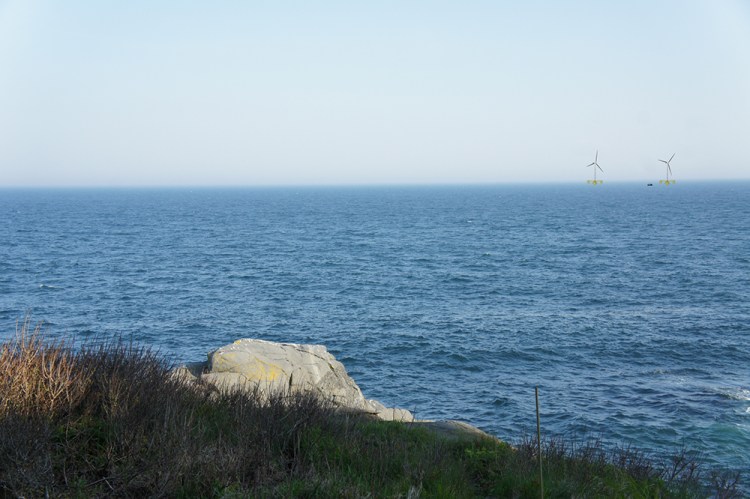AUGUSTA — A bid to move a nationally significant wind energy test site farther from Monhegan Island suffered a major setback on Wednesday when a key legislative committee unanimously voted against a bill to do that. With little discussion, the Energy, Utilities and Technology committee agreed that while some islanders and their supporters had valid concerns about the project, overturning the ongoing review process would set a bad precedent.
At issue is the Maine Aqua Ventus offshore wind project, a plan to test floating turbines roughly 3 miles from the island.
Bill supporters had testified earlier this month that views of two massive floating turbines would jeopardize tourism, lobster fishing, migrating birds and the sense of serenity associated with Monhegan’s wild beauty. The University of Maine-led project initially promised a small, brief test, but it since has expanded to full-size turbines that could be in the water for 20 years.
But opponents of the bill, which would have moved the test site at least 7 miles farther out to sea, said relocation would kill the project and the federal funding needed to complete it. Project representatives noted that the site was chosen through a rigorous state process, had survived a court challenge, was endorsed last year by legislative leadership and is still subject to detailed reviews by federal and state agencies.
After the hearing, a disappointed island resident who led the effort to move the project said his group would consider what to do next, and didn’t rule out legal action.
“We’re prepared to go forward,” said Travis Dow of Protect Monhegan. “We need to fight for what we believe in.”
Jake Ward, vice president for Innovation and Economic Development at the university, said the vote removed one obstacle to the project, which still faces a year-long review by the federal Department of Energy and other agencies.
The Department of Energy plans to decide whether to award Maine Aqua Ventus up to $40 million in final funding early in 2018. To gather public input, federal officials came to Maine in late February and early March for meetings in Tenants Harbor and on Monhegan. A second round of public hearings will follow a draft Environmental Assessment later this year.
“We still have a long process ahead of us, but it was an encouraging vote,” Ward said.
During a short period of deliberation, Rep. Beth O’Connor, R-Berwick, said she understood the concerns of some residents, but that stopping the project and its ongoing review process would set a dangerous precedent. The committee’s co-chair, Rep. Seth Berry, D-Bowdoinham, agreed, saying it also would send a undesirable signal to energy developers about doing business in Maine. He also noted that most Monhegan residents who testified at the public hearing wanted to project to go ahead.
Wednesday’s vote came after a well-attended public hearing before the committee earlier this month, at which opponents of the bill, who included several island residents, outnumbered Dow and his supporters by a 2-to-1 margin.
Maine Aqua Ventus representatives testified that the bill would have the practical effect of ending Maine’s bid to build the country’s first commercial-size, floating wind turbines and jump-start an industry around offshore, deep-water wind.
But representatives of the Maine Lobstering Union, which represents 500 fishermen, said wind power has no place on the Maine coast. If the industry takes off, undersea cables and moorings associated with offshore wind farms would destroy valuable lobster habitat and imperil fishing.
The University of Maine-led venture has spent years surveying wind and wave patterns, marine life and bird migration at a site on the edge of state waters. Based in part on the data collected, the project has received $10.7 million from the federal Department of Energy and is eligible for an additional $40 million.
If the project can win permits and secure enough public and private money, the Aqua Ventus team hopes to begin testing a pair of floating turbines in 2019.
The bill would have banned any offshore wind energy project within 10 nautical miles of the Monhegan Lobster Conservation Area. The wind project site is at the southern edge of the lobster zone. The lobster conservation area earmarked in the bill is roughly 30 square miles and surrounds the island. It was created by state law 20 years ago to set aside an exclusive fishing ground for island residents.
In 2009, the state asked Monhegan lobstermen to map the part of the zone where they did the least amount of fishing. They identified a sector on the southwest tip, along the 3-mile state boundary. That’s where Maine Aqua Ventus established its test site.
But Dow complained what started in 2009 as a scaled-down, temporary experiment has grown to a 20-year, full-scale project with blades that would reach 576 feet above the waterline and an undersea cable to the mainland at Port Clyde.
The Monhegan conflict is taking shape just as ocean wind power ambitions are ramping up along the East Coast.
On Wednesday, a subsidiary of the parent company of Central Maine Power, Avangid Renewables, announced a partnership to help develop a large wind energy project off Massachusetts called Vineyard Wind.
The nation’s first offshore wind farm went online last year off Rhode Island. Both New York and Massachusetts are seeking power from big wind ocean farms. These projects would be in shallow water, with turbine towers set in the sea floor using conventional technology used in Europe. Maine Aqua Ventus is pioneering the next generation of wind energy – floating concrete platforms in deep water, far from land, where winds are steady and people can’t see them.
Tux Turkel can be contacted at 791-6462 or at tturkel@pressherald.com
Send questions/comments to the editors.



